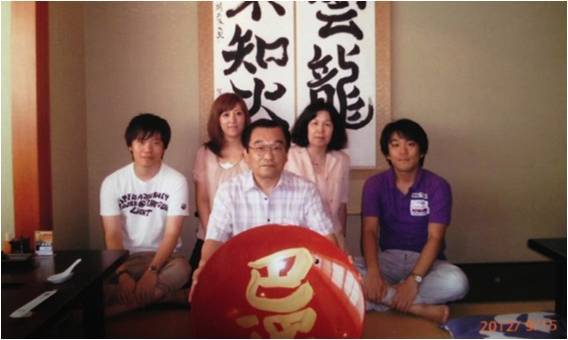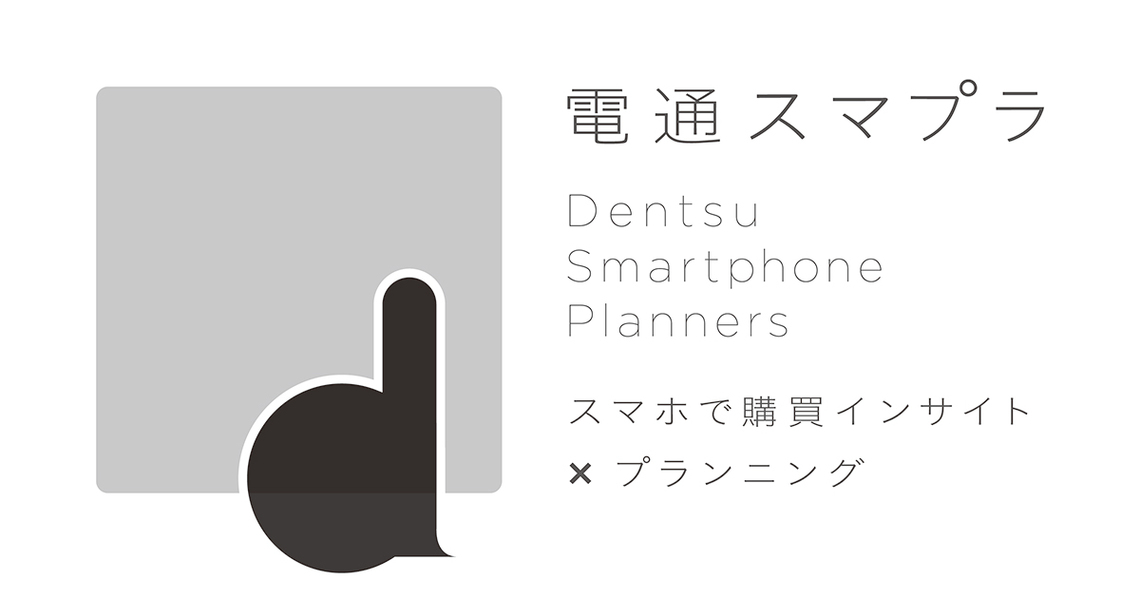Note: This website was automatically translated, so some terms or nuances may not be completely accurate.
In the era of large-screen smartphones, Three perspectives that move the heart, fingers, and the economy.
Whether you're reading this on your smartphone, another device, or a printed copy, hello. I'm Koji Kankaki from Dentsu Inc. Smart Plus. I'm part of the planning unit "Dentsu Inc. Smart Plus," which contributes to launching, growing, and expanding businesses on smart devices like smartphones, serving as the creative lead.
Previously, Smartpla columns have covered smartphone trends, purchasing insights in smartphone games, and TV commercial analysis. Now that the baton has passed to me in the Creative Section, I'll focus on the recently proliferating "large-screen smartphones" and share three perspectives that could offer hints for moving hearts, fingers, and the economy.
1. They are the Master of Disguise
Large-screen smartphones can be considered a hybrid of smartphones and tablets.
Sometimes it's a car navigation system, other times it's educational material. It can be a sketchbook, a business document creation tool, and of course a music player. You can open a browser, read books and manga. This multifaceted device is the large-screen smartphone. I titled this "Pleasant Person with Twenty Faces" not in a suspicious sense, but meaning "pleasant to people." The value of this smartphone-tablet hybrid truly lies in this diversity.
Beyond existing e-books, I sense a growing trend where everything that uses paper as a medium is being further digitized by large-screen smartphones. Personally, I love paper—my desk is piled high with books and manga, and I often wander bookstores window-shopping without any particular purpose. Yet, I'm also increasingly using digitized paper media on my large-screen smartphone.
For example, in educational settings, I often hear about cases utilizing tablet devices. Since many of these children also have kids' mobile phones, it's possible that in the near future, tablets and kids' phones will be combined into a single "large-screen kids' smartphone." The idea is a hybrid device combining two functions: interactive entertainment-education (commonly called edutainment) – not just scanned digital textbooks – and safety and security features for children.
On a personal note, this month marks World Food Day. To create opportunities for reflection on global food issues alongside NPOs/NGOs, I developed a website. This content was also designed as video material intended for viewing on large-screen smartphones. By archiving it, we aim to make global food problems feel more relatable. I feel sharing it with friends – like saying "Hey, check this out!" and handing it over right then – is much easier than with a smartphone. I remember back in the day, my brother and I would fight over a single handheld game console. My brother would usually end up playing, but I'd burrow into his coat pocket, staring intently at the tiny screen. Perhaps the value of a "large-screen smartphone" lies in the ability to share the screen in real life.

Reference: "World Food Day" Month - Web Movie on Thinking About Eating
"The Story of Leftovers" (Special content released 10/16)
http://www.worldfoodday-japan.net/nokomono.php

A photo of my mother squinting as she pinched out on her feature phone
Speaking of my brother, I also remembered when we took a family photo to celebrate my father's 60th birthday. Even after I sent the photo to my mother, she complained, "What's this? It's so tiny I can't see a thing!" She squinted and desperately tried to zoom in on her feature phone screen by pinching out (the action of enlarging the screen with thumb and index finger). I couldn't help but laugh at the sight. I don't know if my parents back home will ever get large-screen smartphones, but I thought it might be possible if they shared one device as a couple. Not a PC, not a regular cellphone. Not a smartphone, not a tablet. If they had one large-screen smartphone serving as a "high-definition digital album," I felt it could be incredibly useful for photos, videos, and online calls.
2. Experiencing with Eyes, Ears, Mouth, and Fingers
Entering the era of large-screen smartphones, I feel the style of phone calls has changed. When I was a child, we used rotary-dial landlines, turning the numbers one by one with a "click," holding the large receiver between our shoulder and ear like a Hollywood detective, with a notepad in our left hand and a pencil in our right. Later, when I got a mobile phone, I'd snap open the flip phone like a Western gunslinger, open my arm, and hold it to my ear. Then came the large-screen smartphone. Its size was one thing, but its thinness meant you had to raise your shoulder quite high to wedge it between your shoulder and chin. It was also a bit too big to hold under your arm against your ear. As a result, I started using a microphone-equipped earpiece, holding the smartphone with both hands, opening an app, and making video calls.
What I find convenient about large-screen smartphones is that by holding it with both hands and using earphones, I can see the other person's face through the camera while talking and still operate the screen. Sure, you might say, "That depends on the person," or "You could do that with previous smartphones too!" But I think there's a hint for practical use here. I recently started online English lessons. Being able to speak English while seeing the foreign instructor's expressions through the camera is great, of course. But I also felt that if I could simultaneously communicate via text for words I didn't catch, it would make for a much more fulfilling lesson. The future where communication like "seeing, listening, speaking, and typing all at once" – something difficult on a small screen – becomes easily possible seems like a benefit of the large screen.
Of course, you can type while on a call with a PC or tablet, but the key point is that smartphones are always with you, making this possible anytime, anywhere. I felt the value here lies in a hybrid that combines the best aspects of smartphones and tablets. I think we'll see more business applications, forms of expression, new games, and entertainment emerging specifically for large-screen smartphones – devices uniquely capable of simultaneously providing the four physical experiences of "eyes, ears, mouth, and fingers" anytime, anywhere.
3. A size that makes buying, acquiring, and owning intuitively enjoyable
What problem does the large-screen smartphone solve for the world at this precise moment? What is its ultimate goal? What ideas drive it? What legacy will it leave? I believe there must be some kind of social significance to it. Did this screen size emerge as a natural progression, or is there a reason behind it? If so, what is it? Beyond the physical aspects—like improved visibility, higher resolution, easier typing, better gaming, or conversely, larger size making it harder to fit in pockets or type with one hand—I'm interested in why humanity arrived at this size, this "large screen" dimension.
What I'm focusing on is a hypothesis: that large-screen smartphones might allow us to more intuitively experience the simple joy of fulfilling fundamental human desires—buying, acquiring, possessing—desires that have become somewhat obscured by vague shifts in the times. After passing through eras of mass consumption and mass production, through the era of "mottainai" (waste not, want not), through recession, deflation, and tax hikes, I feel consumers have, in a sense, become more rational when it comes to purchasing things. As mentioned earlier, the "Kai-jin Nijūmen-sō" concept—which addresses diverse needs while simultaneously encouraging unprecedented actions experienced "through eyes, ears, mouth, and fingers"—might be precisely what large-screen smartphones are: devices that intuitively remind us of the pure joy and delight in "buying, acquiring, and possessing."
As Dentsu Inc. Smart Plaza's ongoing column series has shown, smartphones are emotional devices. Research indicates that people who make in-app purchases in smartphone games all have reasons like "Well, because of XX," and their satisfaction remains high even after spending. Following this trend, large-screen smartphones could accelerate both convenience and motivation within the "purchasing experience." For instance, in smartphone games, richer expressions become possible, drawing in those who previously kept their distance thinking, "It's just a smartphone game, right?" Image and video quality will improve, and the time spent viewing content on large-screen smartphones will steadily increase. In e-commerce too, opportunities for more intuitive, emotionally driven purchases will increase. For fashion, full outfits can be viewed; for cooking, simple recipes fit on one screen. More appealing product displays become possible, and split-screen functionality allows simultaneous viewing of product images and payment screens. We at Dentsu Inc. Smart Plus are here to help seize these business opportunities.
Thank you for reading to the end. The "large-screen smartphone"—neither PC nor mobile phone, distinct from both smartphones and tablets—holds immense potential for the future, extending far beyond its larger display. We aim to conceive and shape great ideas that move hearts, fingers, and economies on these large-screen smartphones.

◎ What is "Dentsu Inc. Smartpla"?
It is a planning unit that contributes to the launch, growth, and expansion of businesses on smart devices (such as smartphones, PCs, and tablets).
Our team includes diverse professionals such as strategic planners, communication planners, consultants, copywriters, and producers, all with extensive experience in marketing communications for smartphone games and apps. Furthermore, as each member possesses a deep passion for specific subjects, we support marketing activities by not only delving deeply into challenges but also engaging clients with our unique personalities and human skills.
Was this article helpful?
Newsletter registration is here
We select and publish important news every day
For inquiries about this article
Back Numbers
Author

Koji Kankaki
Dentsu Inc.
Third CR Planning Bureau
Copywriter/CM Planner
Joined Dentsu Inc. in 2006. After working in the Sales Division, transferred to the Creative Division. Currently striving daily to become an integrated creative director who solves all kinds of challenges with ideas—writing copy, planning commercials, being called upon as a digital specialist for teams, assisting with business development. Awarded at D&AD, One Show, and others.